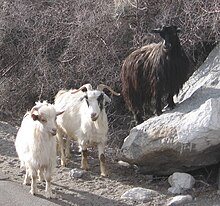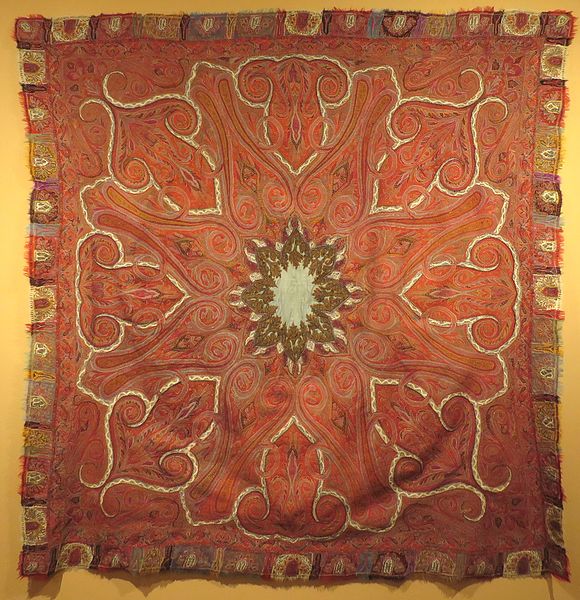Cashmere wool
As Kashmir is called the precious hair of the cashmere goat .
The term cashmere wool is rather contradictory and in German usage it is an unfortunate choice because the term wool is, strictly speaking, assigned to sheep in textile production. A distinction is made between wool (from sheep) and fine hair (from cashmere goat, camel, alpaca, yak). What the noble hairs mentioned here have in common is that they have a scaly edge height that is only about half as high as wool. They also differ in the number of scales per unit length and characteristic. This is why precious hairs of the same diameter feel a little softer and smoother than wool. Modified fine wool is called "Kaschwool", which can be chlorinated and is modeled on cashmere in a stretching process.
The name is derived from the Kashmir region . The genus of the floppy-eared, horned cashmere goats, which is at home there, has around 20 cultivated forms and comes in the colors white, gray, brown or black. It belongs to the family of domestic goats , a subspecies of the woolly goat . Cashmere wool has been used in their homeland since around 1000 BC. Handcrafted into high-quality textiles .
The most important producing countries today are China , Mongolia , Iran and the Central Asian highlands ( Pamir ). However, there are also large breeding farms in Australia , New Zealand and Scotland . The smaller producers include Kyrgyzstan . The regional industry has specialized in the manufacture of garments such as scarves and hats.
properties
The undercoat of the cashmere goat, which has been cleaned from the outer hair (synonymous with awns ), is particularly fine, with a diameter of only 15 to 19 micrometers and a length of 25 to 90 millimeters. The average diameter of the hair is allowed to American definition 19 microns do not exceed, with a variation coefficient of 24% and a maximum of 3% of hair having a diameter of about 30 micrometers. Due to its fine fibers, cashmere is one of the noble hairs with very good heat retention properties and low weight.
Cashmere is one of the most valuable and expensive natural fibers and is therefore often offered mixed with merino wool or other sheep wool . The selling price depends on the quality of the cashmere. The hair should be as fine (thin), long, frizzy and light (white) as possible; Like other wool, they absorb dyes well.
Extraction
- Combing out: the fur is combed out during the coat change at the end of winter or in spring. Some of the goats are also sheared by machine. Approx. 150 grams are collected per animal.
- Sorting is done by hand according to colors and bad parts, washing is carried out to remove grease and impurities.
- De-awning: the coarse outer coat ( awns ) is separated from the desired fine undercoat, today also mostly by machine.
Labeling of goods
In the European Union, according to the Textile Labeling Ordinance 1007/2011, a product labeled exclusively with cashmere must contain at least 85% cashmere wool. Goods with a cashmere content should have a minimum cashmere fiber content of 14.5%. Only goods of the highest quality made from pure cashmere wool may be labeled 100% cashmere .
Sometimes a so-called " pashmina wool" is supposedly even more valuable . This comes from special mountain goats from the Himalayas (e.g. the Chyangra goat ) and differs in this from Kashmir. In reality, pashmina scarves are traditionally made from ordinary cashmere.
history
In Europe, cashmere scarves became known around 1800 and quickly became an indispensable part of women's wardrobe of the 19th century, especially in the Directoire , Empire , Biedermeier and during the Second Empire . In addition to valuable original cashmere, however, cheaper copies also came onto the market.
Gallery: Historical cashmere scarves
Jamewar scarf, Kashmir, early 19th century, Honolulu Museum of Art (top: detail; bottom: general view)
Cashmere pattern scarf (detail), between 1850 and 1949, Musées départementaux de la Haute-Saône
See also
- Shahtoosh , wool of the Tibetan antelope
Web links
- Cashmere & Camel Hair Manufacturers Institute
- SZ-Magazin 44/2015: "We were amazed at how good the counterfeiters are"
Individual evidence
- ↑ "The finer the better" In: D + Z, volume 56.2015: 4
- ↑ HK Rouette: Encyclopedia of textile finishing. Woodland, Cambridge 2001, ISBN 1-84569-065-6 .
- ↑ CCMI association definition of cashmere wool. ( Memento of the original from March 3, 2013 in the Internet Archive ) Info: The archive link was inserted automatically and has not yet been checked. Please check the original and archive link according to the instructions and then remove this notice. Retrieved January 22, 2013.
- ↑ Cashmere & Camel Hair Manufacturers Institute ( Memento of the original dated July 23, 2012 in the Internet Archive ) Info: The archive link was inserted automatically and has not yet been checked. Please check the original and archive link according to the instructions and then remove this notice. . Retrieved October 20, 2013.
- ↑ Austrian Federal Ministry of the Interior . Retrieved October 20, 2013.
- ↑ Ludmila Kybalová, Olga Herbenová, Milena Lamarová: The great image lexicon of fashion - from antiquity to the present , translated by Joachim Wachtel, Bertelsmann, 1967/1977: p. 268, p. 473–474.




